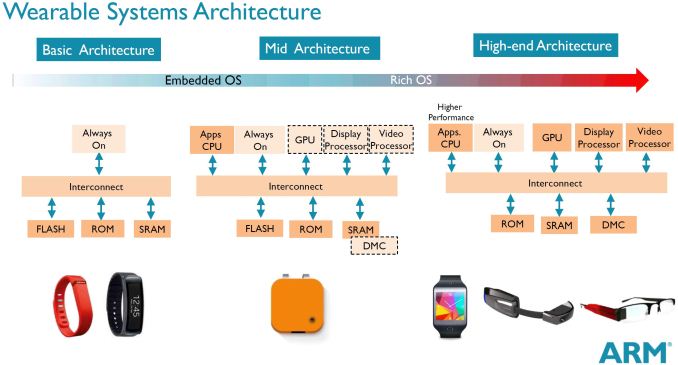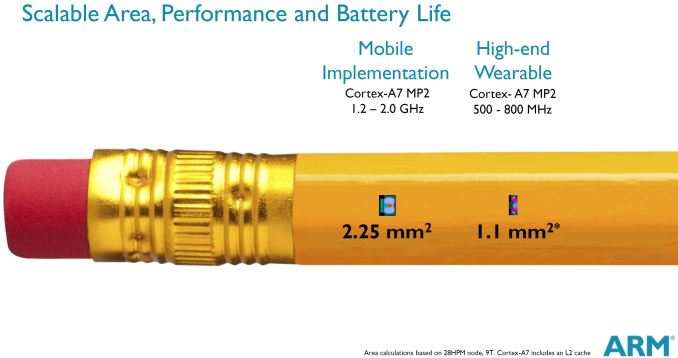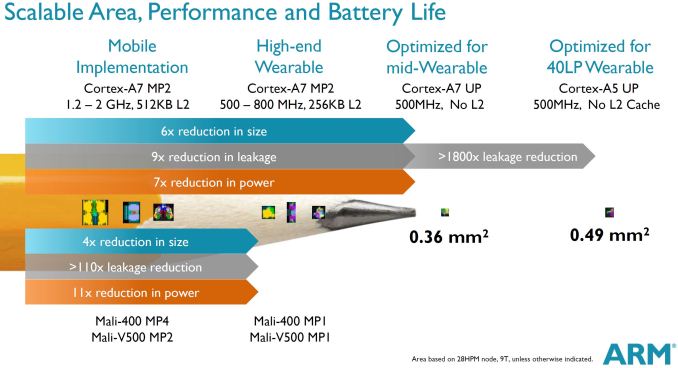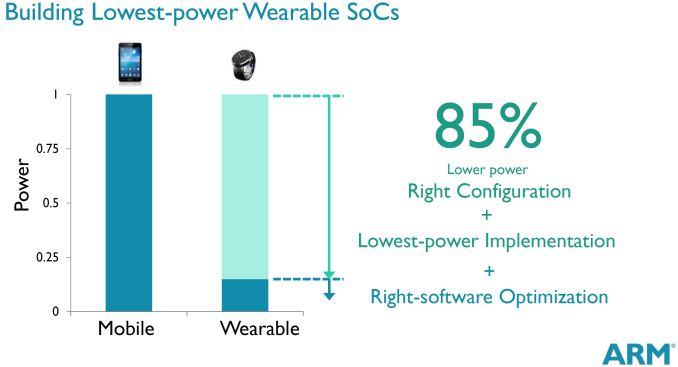Cortex-M7 Launches: Embedded, IoT and Wearables
by Stephen Barrett on September 23, 2014 7:01 PM ESTHybrid Systems
While the Cortex-M series aims to be the MCU for many application markets including IoT and wearables, ARM does not expect M series processors to always be used alone and expects many devices to combine A series application processors with the M seires. When I mentioned the word coprocessor referring to the M series, Nandan quickly pointed out that in this market, the A series might actually be considered the coprocessor. Considering the MCU is the always on device and the A series CPU wakes only sparingly, I can see his point of view. The following diagram from ARM lays out this perspective well.
MediaTek used a much simpler table to describe the sub markets of IoT and wearables that, as I noted at the time, insinuated there was no overlap between MCUs and APs. I tend to agree more with Intel’s Edison platform and ARM’s slide here that there are large market segments that will indeed be combining these differentiated processors.
When designing hybrid systems like this for IoT and wearables, it is very important to synthesize the AP with power optimization goals. The process of synthesizing HDL to an ASIC is essentially an optimization problem, much like all engineering. Targeting one aspect of performance, such as power consumption, means you’re willing to sacrifice something else. The prevailing trend so far has been to reuse smartphone processors in wearables. Companies practicing this approach are not optimizing their wearables' power use but are instead optimizing time to market and internal expenses.
To emphasize what this means, when the Cortex A15 launched ARM stated it was optimized for 1.2 GHz operation. When the first smartphone featuring an A15 hit the market it actually ran at much higher voltages to achieve higher frequencies and thus relatively high power consumption. Reusing this chip inside an IoT or wearable device is not only choosing a performance focused CPU instead of a power optimized one like the A7, but it has also been synthesized to further push the CPU away from power efficiency. This is why many wearables today featuring rich operating systems have struggled with battery life. Apple has traditionally been conservative with smart phone SoC power consumption and it will be interesting to see how their new wearable is designed.
For wearable devices, ARM recommends reducing A series frequency and area by over half, which has a direct effect on power consumption. ARM states that wise choices of CPU cores and caches, synthesis goals, and software optimizations to offload certain tasks to an MCU, can reduce power consumption by as much as 85%. This will be something we will keep an eye on when we review future wearables.














43 Comments
View All Comments
Stephen Barrett - Tuesday, September 23, 2014 - link
ARM specifically advised against comparing performance numbers across architectures, saying it was an apples and oranges comparison.Despite similar numbers in these very synthetic benchmarks, when running actual application code , the M7 will never compete with the A series. The numbers are only useful comparing within the family.
Wilco1 - Wednesday, September 24, 2014 - link
Sure an M7 will never run Android, but that's not the point. v7-M and v7-A share the same Thumb-2 ISA and use the same compiler backend, so it's not apples/oranges. You can run the same binary on an M7 and A7 if you wish.Due to its shorter pipeline, an M7 should beat an equivalently clocked A7. Of course an A7 can clock 2 times as high in 28nm so it wins in absolute performance. However that still means M7 is a huge leap from an M3/M4.
tuxRoller - Wednesday, September 24, 2014 - link
The chart says 2.14-3.23 dmips/mhz, or 5.04 coremark/mhz, so atom d525 or core i5-2400 for coremark, or between intel pentium/pentium pro and pentium 3.http://www.eembc.org/coremark/index.php
https://en.wikipedia.org/wiki/Instructions_per_sec...
Flunk - Thursday, September 25, 2014 - link
Intel Quark.KlausWalter - Wednesday, September 24, 2014 - link
For those guys who understand german here is the best review so far including the first implementation of the Cortex-M7 in a real MCU, a so called STM32F7 Family delivered by ST Microelectronics: http://www.elektroniknet.de/halbleiter/mikrocontro... Google translator may help....uningenieromas - Wednesday, September 24, 2014 - link
The three big guys in the MCU world (Atmel, Freescale and ST) are already working in Cortex M7 processors and I'm sure they already have a internal implementation of the MCUs:http://www.arm.com/about/newsroom/arm-supercharges...
Freescale has it already in it's roadmap, and it's called Kinetis X.
jdesbonnet - Wednesday, September 24, 2014 - link
Microchip is also a 'big guy' but is conspicuously absent from the ARM party. Which is a pity: I like their stuff, but I've now standardized on the ARM Cortex-M family of MCU.ah06 - Wednesday, September 24, 2014 - link
So we expect to see this as the core of an SoC in wearables and for high end wearables, ARM recommends a gimped A7. Well what about the R series that falls right in between?I'm still very fuzzy on the relative comparisons between the wearable processors. Maybe do an article comparing Aster platform (ARM7ESJ), Cortex-M4/M7, Cortex-Rx, Cortex-A7/A53
Thanks
FunBunny2 - Wednesday, September 24, 2014 - link
-- the M series processors are considered microcontrollers and not application processors, mainly because they lack a memory management unit (MMU).Well, then, the X86 wasn't a real cpu, because the MMU was off chip for rather a while. Not until the 386 was it really implemented.
hammer256 - Wednesday, September 24, 2014 - link
So what are the target market of the M series and R series? R series is higher performance? Both lack MMU right? The distinction between the two lines are kinda blurry to me.